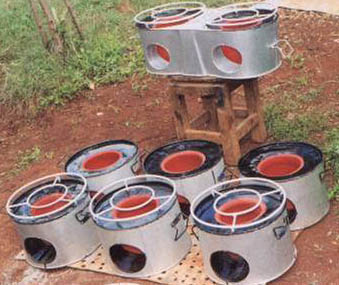
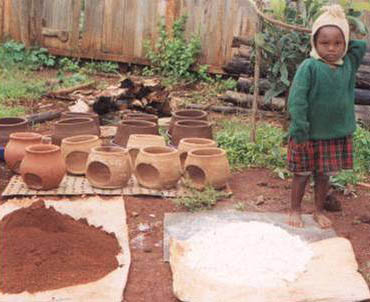
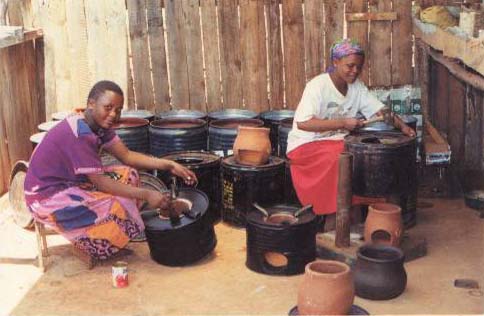
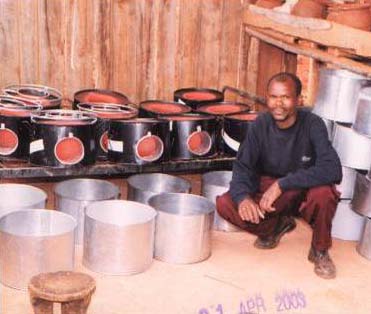
12.5" dia x 9" h, 6" exit, 9" dia firebox, 5" dia fuel feed
Cement and pumice construction with pumice insulation
HENYA STOVE: RICHARD NJAGU, KENYA
Richard Njagu, Dean Still May-June 2003
 |
 |
| Henya Stove June 2003 | Local clays used in Henya Stove May 2003 |
 |
 |
| Making the Henya Stove for firewood in Kamangu Village, Kiambu District April 2003 | Richard Njagu with New Stove Design April 2003 12.5" dia x 9" h, 6" exit, 9" dia firebox, 5" dia fuel feed Cement and pumice construction with pumice insulation |
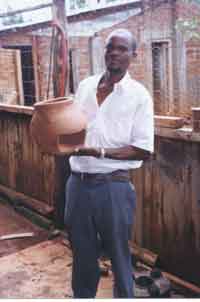 |
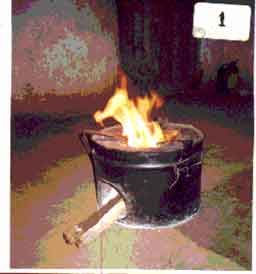 |
 |
| Richard with stove liner 2002 | Henya Stove with Rocket chamber | Rocket stove |
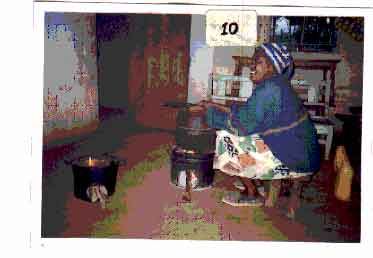 |
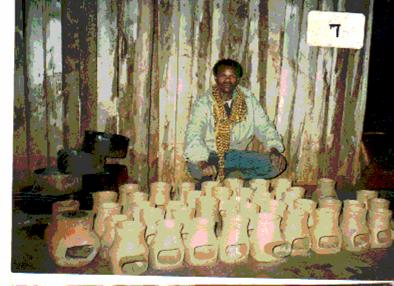 |
Richard Henya Njagu has been making and selling these Rockets for years near Nairobi. Richard was introduced to the Rocket by a Peace Corps volunteer that was trained at Aprovecho. They developed the stove together. I like the stove design (looks like a Rocket Jiko) and Richard reports that women like it because it helps their coughs to improve. Dean Still
INTRODUCTION
My name is Richard Henya Njagu from Kamangu village of Kikuyu near Nairobi Kenya. I was born and brought up in this place which is a semi arid compared with the more productive areas of Kiambu District.
Kiambu district in general is highly populated and this is where the early colonial settlers put their influence by building schools, churches, hospitals and few industries. Land has been divided and subdivided on and on until natural forests are no longer in existence.
People in this District are busy in various fields trying to make a living either in agriculture labour, business, informal light industries, professionals and like.
BACKGROUND
During my young hood, I lived with my parents in a typical traditional Kikuyu homestead and went to local schools just like my friends and neighbours.
After my formal education, I felt I needed to identify with a profession which can be improved and developed with experience.
So I hunted for chance and the nearest I got within reach was among the popular “Jua Kali” artisans in Nairobi. This is an informal sector in Kenya for light industries technicians.
I first joined motor cars mechanics and in time I was capable of repairing petrol engines and later diesel engines. This was just the beginning of a chain of trades and experience as a professional.
The informal sector gained popularity among Kenyans and soon the field was flocked by thousands. This way the survival for the young technicians became very stiff. “When the going gets tough the tough gets going” is the saying that clicked in my minds because life had to continue.
The unfair competition affected the services offered, in quality and charges but since the field is informal, there is no control and the situation is out of question. I felt unsure of progress on my pursuit and decided to retread back home just for survival.
SURVIVAL
At home, I made my home workshop where I made several viable items for customers in the neighbourhood. Those included animal water feeds, bicycle, spares, radio and T.V. repairs etc. I even modified items to improve them.
TECHNOLOGY ADVENTURE
In 1987 still at my home workshop, I felt a little ingenuity within my minds and decided to try for more appropriate technologies.
I made sun cookers, windpower driven machines for producing electric current for lighting houses in the remote areas, and other machines for domestic use. I also made machines for making soilblocks and was able to build a house for my family with very cheap local materials which actually looks standard. I again made fellow cement water tanks and plastic quttars.
The more I improved on technologies, the much I felt encouraged to go ahead. I usually start on one item, and after getting a trainee to do the production under my supervision, I have my minds on another item so that y the time the trainee is well conversed I feel life to be always new.
IDENTIFICATION
In 1994, neighbours caught me with surprise. Community groups and local NGO’s identified my activities and needed my help. Plan-international is a local NGO from Nairobi. They had an office in my area. They hired me for my services to train local artisans on stabilized soil blocks houses and tanks for water. After sometimes, the community groups also demanded my services and hired me to train them on construstions of plastic qutters and kitchen gardens. I enjoy training others on my skills.
RESEARCH
Due to the rising prices of the cooking fuel like charcoal, firewoods, paraffines, gas and electricity my minds work hard and restless looking for alternative energies which can be expensive or use some of them more efficiently and economically.
Families in the rural areas alike those in the urban are today spending a lot of money on cooking fuels. Some are economically forced to use plastic debris which produce intoxicants and thus risking their lifes.
Woodfuel which was originally abundantly available for families in the rural areas is no longer there. This is simply because their small shambas are meant mainly for food production only – women and children have to travel far for search of firewoods and spending many hours which could be put to better use. Inspite of all the labour, families kitchen huts are always covered with soot and excessive smoke during cooking time. I learned those problems during the time I worked with the community groups. Of all the improved stoves I found in their houses including “Maendeleo Jiko, Kuni Mbili Jiko” etc, non2 of them did any good on reducing smoke or doing any conservation of firewoods.
FOCUS
With all my inspired desire to fight those killer problems, I focused my attention on improved stove as my main subject and as a pattern parcel in my technology adventure.
In 1995 Todd Harris was around with the ministry of water and sanitation sent to help work with the rural community in my area. He was a US peace Corps volunteer and was therefore working in the same group of people where I was. Todd was interested very much. He decided to join hands and helped very much in the campaign of introducing my new product to many. He then left the country by 1998.
IMPROVED STOVE
I worked out the design of my first improved stove in 1996. after the construction of the prototype, the testing took me six to eight months and the following analysed statements achieved.
SUPERIORITIES
Charcoal, firewood, corn cobs and other dry rubbish also could be used in the improved stove. I named it “Henya Stove” and is as shown in the brochure. I did not want to trust my findings alone. I of course needed to here from more other witnesses. I constructed fifty (50) more stoves and gave free sample to local women. After some months, I kindly requested them to give to me frank statement on the effects of my improved stove.
The majority were impressed and even re-ordered more for their friends and relatives. I received many positive answers and many of them very encouraging. I as well made an appointment with the University of Nairobi – Chemistry department for Emission and material testing. A report for the comperative testing was written by a graduate Maina David Mwangi. The project report was submitted in partial fulfillment for the degree of Bachelor of Science of the University of Nairobi Kenya. It was with the approval of Dr. J. P. Kithinji University Supervisor.
It wasn’t easy to make a better promotion only from my pocket. I do not have facilities like mobility, telephone, and office and that way I could not reach larger area for demonstration, however a local NGO from Nairobi (AproTech) made some efforts to help my business by little promotion of my stove but for only a short time. I emptied my pockets in the first production of 600 stoves which most of them went to free sample recipients thus making very little profit which could not make me go on with my commercial production.
Richard Henya Njagu
PO Box 98
Kamangu Village, Kikuyu, Kenya
richardnjagu@yahoo.com
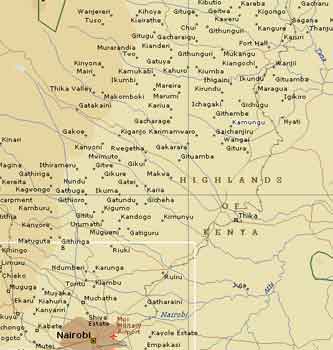 |